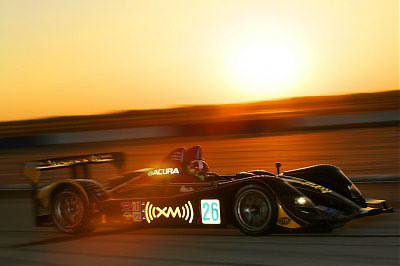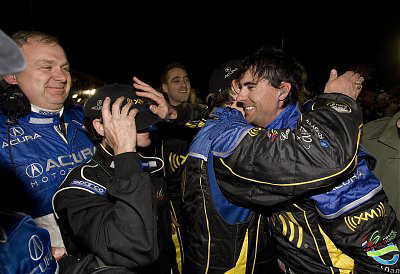The Way It Is/ Audi points to the way forward for the sport
by Gordon Kirby Kimi Raikkonnen demonstrated in Australia last weekend that he's going to be an awfully hard man to the beat in Formula One this year. In his Ferrari debut, Raikkonen started from the pole and ran away on his own, easily scoring his first win in more than a year. The new Ferrari looked superb and despite putting on quite a few pounds over the winter Raikkonen was as fast as ever, making only one, quickly-recovered mistake on his way to victory ahead of the pair of McLaren-Mercedes driven by world champion Fernando Alonso and rookie Lewis Hamilton.
Kimi Raikkonnen demonstrated in Australia last weekend that he's going to be an awfully hard man to the beat in Formula One this year. In his Ferrari debut, Raikkonen started from the pole and ran away on his own, easily scoring his first win in more than a year. The new Ferrari looked superb and despite putting on quite a few pounds over the winter Raikkonen was as fast as ever, making only one, quickly-recovered mistake on his way to victory ahead of the pair of McLaren-Mercedes driven by world champion Fernando Alonso and rookie Lewis Hamilton.
Raikkonen's teammate Felipe Massa was quick in qualifying but broke his transmission after hitting a curb and had to start the race from the back of the grid. Massa came through to finish sixth, lapped near the end by his new teammate.
As Raikkonen disappeared, Alonso chased Hamilton most of the way before making a quicker second pitstop than the young Brit. It was a great result for Ron Dennis and his team, the McLaren-Mercedes proving quick and reliable, if not quite a match for the Ferraris.

© LAT USA
Clearly, Ferrari has produced another excellent car for this season and the team's long relationship with new F1 spec tire supplier Bridgestone has got to be a big plus for the current package. The departures of Ross Brawn, Rory Byrne and Nigel Stepney seem to have had little effect on Ferrari's performance and operational ability, and it seems likely that Raikkonen's blinding speed will finally bring him his first championship this year.
Given his extra weight, it appears that there are fewer curbs on the Finn's legendary partying chez Ferrari than during his days at McLaren, and it will be interesting to see if there's any decline over the next few years in Raikkonen's physical condition and form. But at the moment he looks unbeatable and with a committed, competent tester and good racer like Massa in the second car, the team should be as strong as ever.
The only other team with competitive speed in Australia was BMW with Nick Heidfeld and second-year driver Robert Kubica. Heidfeld qualified third and finished fourth while Kubica was equaly strong before pulling in with a broken transmission, the team's apparent weak point. Not surprisingly, without its former sparkplug Alonso, Renault was disappointing. Team leader Giancarlo Fisichella was a distant fifth and rookie Heikki Kovalainen finished tenth.

© LAT USA
What has changed, of course, is that while Michael Schumacher was the face of F1 for ten years, radiating ruthlessness, ultra-professionalism, discipline and teamwork, Raikkonen's bearing and image is very different. Here's hoping teammate Massa and McLaren men Alonso and Hamilton can give the monotone Finn party-boy a run for his money.
Meanwhile, the real wave of the future for the sport was rolling in once again at Sebring where Audi's turbo diesel R10 won the American Le Mans Series' season-opening, 12-hour race for the second year in a row with Emanuele Pirro/Marco Werner/Frank Biela driving the winning car. The exhaust note-free R10s have dominated long-distance sports car racing over the past year, winning at both Sebring and Le Mans last year and sweeping the ALMS championship. The Audis qualified one-two at Sebring last week but the race-leading Rinaldo Capello/Alan McNish/Tom Kristensen car lost time with a blown tire while Pirro/Werner/Biela ran almost untroubled to the finish. The second R10 made it home in fourth place as Audi continues to race-develop its clean-burning 'green' diesel engine that will be available to the American car buyer within the next eighteen months.
Audi's turbo diesel has created a buzz for the ALMS which has helped bring both Porsche and Acura to the party. And of course, Acura's ALMS debut at Sebring could not have been more successful as the three Acura(Honda)-powered cars scored a stunning debut one-two-three sweep of the LMP2 category after the Penske and Dyson Porsches hit trouble. Andretti-Green's Acura ARX-01a driven by open-wheel aces Bryan Herta/Dario Franchitti/Tony Kanaan finished a superb second overall and the two other Acura LMP2 cars run by Fernandez and Highcroft Racing finished third and sixth overall. Acura and HPD in Santa Clarita have put a huge effort into the new ALMS program and they've made a roaring start as ALMS sports car racing suddenly finds itself the beneficiary of some serious competition among manufacturers.
Both Porsche and Acura were drawn to the ALMS because the series retains a whiff of technology in an increasingly spec-car age but there's no doubt that Audi's turbo diesel sets the standard. The message of Audi's success is that the ALMS and other forms of racing outside NASCAR need to focus on writing formulas that will further encourage green fuel technology. This surely is the way forward for the sport, to return to striving to improve the breed like racing used to in the first two-thirds of the twentieth century.
I've written before that both the Indy 500 and Formula 1 should be making serious moves in this direction, but few sanctioning bodies seem to be interested or have the capability of writing real 'green' fuel rules. F1 should be in the vanguard of this movement, but Max Mosley and the F1 manufacturers seem to be preoccupied with electronics and aerodynamics rather than encouraging new fuel technology. If the sport really is to contribute to the demands of the 21st century beyond being a mere entertainment and marketing medium it must surely be as a laboratory for greener fuels. While IRL, Champ Car and NASCAR are mired in spec-car thinking, F1 has the ability, constituents and platform to step up to this challenge.
Of course, the Indy 500--where innovation once ruled--should be leading the charge in this regard, not by the mere political expedient of adopting ethanol fuel, but by writing bold new engine rules for 2009 or 2010 that would bring technology back to the Speedway. It might also keep Honda racing in the IRL and attract new manufacturers to Indy car racing while the status quo is likely to result in Honda's departure from the IRL and the final demise of manufacturer involvement in Indy car racing.
Honda is a key element in all this. As well as being an R&D and racing-based company, it's probably fair to say that Honda has done more work on alternative fuel road cars than any major manufacturer, Toyota included. Honda has certainly been way ahead of Detroit in pushing the envelope to develop electric, fuel cell and hybrid cars. Through its Acura brand, Honda has just started a new journey in the ALMS and sports car racing in pursuit of technical development. As regular readers know, I took a detailed looked at the thinking behind the Acura ALMS program in this space on February 12 and after it made such a rousing start at Sebring last weekend you can be sure the Acura program will be more and more central to American Honda and HPD's efforts over the next few years.
I find it both interesting and sad that Honda's rather wayward F1 team has adopted a strictly pr-driven and much-ridiculed attitude to green technology this year which is almost the opposite of the company's real approach to the matter. Honda's conspicuously unsuccessful F1 team is considered by many in the business to be a bureaucratic nightmare rather than a race team and based on the Australian F1 opener the team is in for a difficult year.
On the other hand, Honda has achieved instant success in the ALMS by going racing in partnership with established race teams rather than trying to run its own operation. This is the way Honda achieved great success in CART and then the IRL, and the company is applying the same principals to its Acura program with Andretti-Green, Fernandez and Highcroft Racing. There may be a lesson there for Honda in how to turn around its mediocre F1 team.
But the bigger message is that it wouldn't take much of a nudge for Honda to add serious green fuel technology to its racing program whether it's in F1, ALMS or IRL. The successful sanctioning bodies of the 21st century outside NASCAR will be those who write green fuel rules and get manufacturers like Audi, Honda, Porsche, Toyota and BMW fully committed to a like-minded vision for the future.
Auto Racing ~ Gordon Kirby
Copyright 2007 ~ All Rights Reserved
Copyright 2007 ~ All Rights Reserved
Top of Page